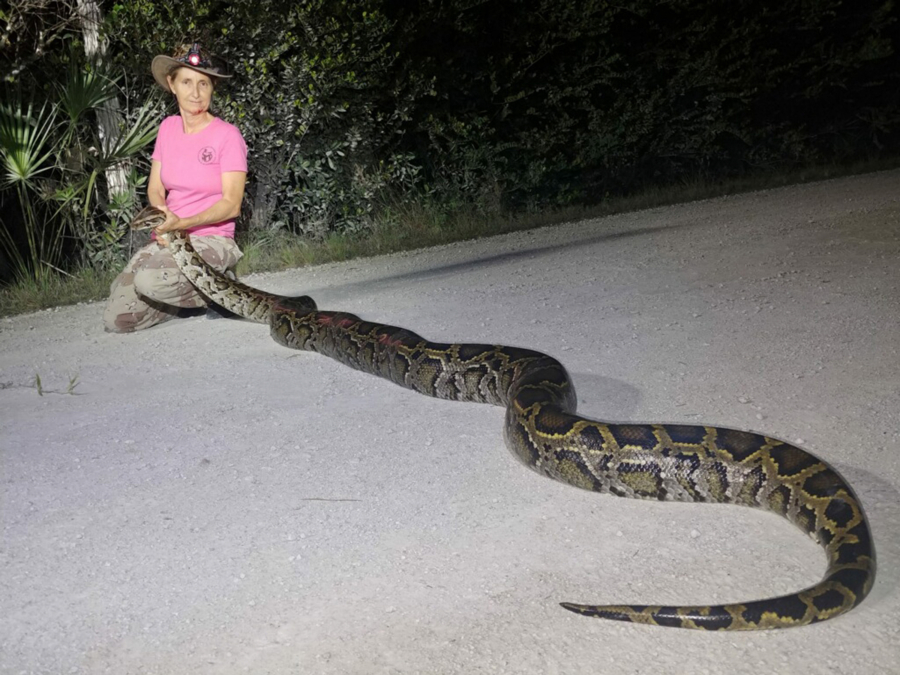MIAMI — For most people, encountering an 18-foot-long python can be a terrifying experience. For Donna Kalil, who left her lucrative job as a real estate agent to become a hunter of the powerful snakes, it’s “a very exciting thing.”
Kalil decided to start capturing Burmese pythons in the Everglades after reading a story in the Miami Herald about one of the snakes blowing up when it swallowed a 6-foot alligator after a confrontation in 2005.
She realized there was a problem with these snakes, although she did not know how big it was, and she turned her life upside down to help remove pythons in the fragile Everglades ecosystem, where they are an invasive species.
Pythons have a tremendous impact on native Florida wildlife. They prey on 24 species of mammals and 43 species of birds. They also eat alligators, according to data from the Conservancy of Southwest Florida.
Burmese pythons established themselves in Florida as a result of escaped or released pets and were first discovered in the Everglades nearly two decades ago. They have become the Everglades’ top predator, according to the Florida Fish and Wildlife Conservation Commission.
Scientists estimate that there are about 300,000 pythons in the Everglades.
“You make much more money in real estate than capturing pythons. I now earn the minimum wage plus an amount for the snakes that I capture, but what I am currently doing is much more satisfactory. And it’s a way to give back to the community where I grew up,” Kalil said.
She does not regret her decision, saying she has one of the best views in the world, the Everglades, and there’s always the adrenaline rush of knowing that at any moment she can run into an 18-foot giant.
“It’s very exciting every time you come across a python and you know that every time you catch one you are helping to preserve the native wildlife of the Everglades. Despite becoming a problem in South Florida, pythons are majestic animals,” said the 58-year-old hunter.
Even though Kalil had a career in real estate, she says she has captured snakes all her life and has had a fascination with them since she was 5. She was living with her family in Caracas, Venezuela, when her brothers brought home a snake they didn’t realize was venomous. Luckily, she says, it didn’t bite her.
“Even though I had been told not to, I found her fascinating, and thank God she didn’t bite me. The snake was possibly a coral because I remember that it had very beautiful rings,” she recalled.
Living in Venezuela, where her father was stationed for the U.S. Air Force, she was exposed to all kinds of animals, she says. Many wandered through the family’s yard, and a wooded area behind her house helped her discover animals in nature.
When she first set out to capture pythons it didn’t go very well, Kalil said. But since then she has become an avid catcher, using her hands to snag 481 of the constrictors to date.
Kalil was the first woman hired by the South Florida Water Management District for its python eradication program in 2017. It has been her full-time job since.
There are currently 15 women who are certified python capturers, but she was the first woman in that first season, which brought out a total of 25 hunters.
The “first monster” she encountered, she says, she found after midnight in the Everglades and was between 17 and 18 feet long. At the time she had been a python catcher for six months and was out hunting with a friend.
The python attacked her and Kalil had to shoot it, but she used the wrong bullets and didn’t kill it. The projectile ricocheted off the snake’s head, and the python fled.
“A snake of that size is terrifying because you know that pythons of that size have eaten people,” she said. “We don’t usually shoot them, that was the only time I used a firearm, but I couldn’t catch something that big on my own. Fortunately, it decided to leave instead of attacking me again.”
That was the largest python she has encountered, though she has captured two that were about 15 feet long.
“They are very, very powerful. Not only do you have to grip them very well, you have to know what you are doing because it can be very dangerous,” she said. “Even a small one can wrap around you. They’re constrictors, and you can get in trouble if they wrap around your neck.”
Despite the dangerous nature of her work, Kalil said protecting the other animals in the Everglades from the pythons is important work.
“We want to eliminate as many pythons as possible so that the native animals have a chance to live.”




